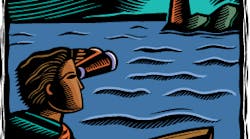By planning ahead, stringently tracking labor and materials, and documenting weekly site progress, project managers can map out their next OSP project to the last detail.
Our forefathers navigated great bodies of water with just hand-drawn maps and a little knowledge of astronomy and nature's signs. Needless to say, they only reached their original destinations occasionally — and rarely on any predictable schedule. Obviously, these inefficient but amazing feats aren't necessary anymore. Today, ship captains have an arsenal of advanced technology tools at their fingertips to help guide their vessels, including GIS and GPS systems as well as devices that help them avoid difficult weather or dangerous currents, maintain safety, and meet rigid schedules.
OSP project managers are similar to those long-gone captains. Using advanced scheduling and pricing software to help build a project map, today's project managers no longer have to rely on notebooks, calendars, and sticky notes. Now they can schedule pre-surveys, deliver construction drawings, and define material purchase orders electronically. They can also track them to delivery, assign construction personnel resources and schedules, build construction sequences, prepare equipment requirements, and even coordinate scheduling with others with the click of a mouse.
With these complex matters mapped out on a custom-built basis for your OSP project, you can help meet the required completion schedules and reduce your costs due to unnecessary delays or inefficiencies.
In this 11th installment of EC&M's 12-part look at the Second Edition of BICSI's Customer-Owned Outside Plant Manual, we'll take you through some of the considerations involved in developing a good project management plan as they relate to your OSP construction needs. Many of your decisions for the design or management of the design process should be concluded and documented at this point.
Points on the map
When mapping out your construction plan, the manual outlines the following points to help you reach your final destination:
-
Integration
-
Scope
-
Time
-
Cost
-
Quality
-
Human resources management
-
Communications
-
Risk
-
Procurement
By using these points, you can organize your plan into clearly defined steps, assigning defined periods of time, resources, and associated costs to each task. After defining these tasks, you must relate them in the proper order and create controls on dependent tasks. In other words, you need to complete a task before starting the next one. This process is known as work breakdown structuring (WBS).
Timing is everything.
Because you have to expect the unexpected on OSP projects, it's important to allocate sufficient time and resources for the routine tasks while allowing lag time between tasks. The amount of time you need for each task will depend on the length, quantity, and difficulty of the work.
If one task runs behind schedule, all dependant tasks may fall behind, too. The project manager's responsibility is to track the job's progress and make schedule adjustments accordingly, which in some cases means doubling your resources or requiring overtime.
Material considerations.
Another important role for an OSP project manager is to stay on top of materials. A good project manager always assembles a list for the entire project to track materials — starting with purchase orders and going all the way up through handling and inspection of final placement inventories. Including a checklist with the schedule helps project managers place crews as well as track supplies. Once material has been handed out to the crews, they're required to report the usage and completion of the placement of those materials.
On poorly managed projects, materials often don't meet originally planned deadlines, which creates critical delays in many task assignments. Because many tasks can't be started without these materials, it's crucial to meet them. Therefore, project managers shouldn't assign times to tasks before guaranteeing delivery commitments by suppliers.
Time management.
The project manager has a continuous role in keeping the project's schedule on track. The manual suggests documenting certain elements of the project on a weekly basis and recording the following information.
-
List of subcontractors.
-
Approximate personnel count.
-
Accidents and unusual events.
-
Meetings and significant decisions.
-
Stoppages, delays, shortages, and losses.
-
Emergency procedures.
-
Change orders — received, implemented, and in-process.
-
Services connected and disconnected.
-
Equipment or system tests and start-ups.
-
Status of material orders.
-
As-built documentation status report.
-
Punch list status.
-
Weather conditions.
-
Time sheets.
-
Daily job reports.
In the final installment of this series, we'll be including all 11 previous topics in a case study of an OSP project from beginning to end. This article will feature a customer-owned project example that will require citing the material and guides in the Second Edition of BICSI's Customer Owned Outside Plant Manual.
Hite is special projects engineer-OSP for CT Communications, Inc., Concord, N.C.
The material for this article was excerpted with permission from BICSI's Customer-Owned Outside Plant Design Manual, Second Edition.



